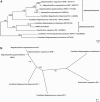Common ancestry of iron oxide- and iron-sulfide-based biomineralization in magnetotactic bacteria
- PMID: 21509043
- PMCID: PMC3176509
- DOI: 10.1038/ismej.2011.35
Common ancestry of iron oxide- and iron-sulfide-based biomineralization in magnetotactic bacteria
Abstract
Magnetosomes are prokaryotic organelles produced by magnetotactic bacteria that consist of nanometer-sized magnetite (Fe(3)O(4)) or/and greigite (Fe(3)S(4)) magnetic crystals enveloped by a lipid bilayer membrane. In magnetite-producing magnetotactic bacteria, proteins present in the magnetosome membrane modulate biomineralization of the magnetite crystal. In these microorganisms, genes that encode for magnetosome membrane proteins as well as genes involved in the construction of the magnetite magnetosome chain, the mam and mms genes, are organized within a genomic island. However, partially because there are presently no greigite-producing magnetotactic bacteria in pure culture, little is known regarding the greigite biomineralization process in these organisms including whether similar genes are involved in the process. Here using culture-independent techniques, we now show that mam genes involved in the production of magnetite magnetosomes are also present in greigite-producing magnetotactic bacteria. This finding suggest that the biomineralization of magnetite and greigite did not have evolve independently (that is, magnetotaxis is polyphyletic) as once suggested. Instead, results presented here are consistent with a model in which the ability to biomineralize magnetosomes and the possession of the mam genes was acquired by bacteria from a common ancestor, that is, the magnetotactic trait is monophyletic.
Figures


Similar articles
-
Comparative genomic analysis of magnetotactic bacteria from the Deltaproteobacteria provides new insights into magnetite and greigite magnetosome genes required for magnetotaxis.Environ Microbiol. 2013 Oct;15(10):2712-35. doi: 10.1111/1462-2920.12128. Epub 2013 Apr 23. Environ Microbiol. 2013. PMID: 23607663
-
Single-cell genomics reveals potential for magnetite and greigite biomineralization in an uncultivated multicellular magnetotactic prokaryote.Environ Microbiol Rep. 2014 Oct;6(5):524-31. doi: 10.1111/1758-2229.12198. Epub 2014 Aug 28. Environ Microbiol Rep. 2014. PMID: 25079475
-
Morphological and cellular diversity of magnetotactic bacteria: A review.J Basic Microbiol. 2018 May;58(5):378-389. doi: 10.1002/jobm.201700383. Epub 2017 Nov 7. J Basic Microbiol. 2018. PMID: 29112284 Review.
-
Applications of Magnetotactic Bacteria, Magnetosomes and Magnetosome Crystals in Biotechnology and Nanotechnology: Mini-Review.Molecules. 2018 Sep 24;23(10):2438. doi: 10.3390/molecules23102438. Molecules. 2018. PMID: 30249983 Free PMC article. Review.
-
Bacterial magnetosomes: microbiology, biomineralization and biotechnological applications.Appl Microbiol Biotechnol. 1999 Oct;52(4):464-73. doi: 10.1007/s002530051547. Appl Microbiol Biotechnol. 1999. PMID: 10570793 Review.
Cited by
-
A Novel Isolate of Spherical Multicellular Magnetotactic Prokaryotes Has Two Magnetosome Gene Clusters and Synthesizes Both Magnetite and Greigite Crystals.Microorganisms. 2022 Apr 28;10(5):925. doi: 10.3390/microorganisms10050925. Microorganisms. 2022. PMID: 35630369 Free PMC article.
-
Magnetic genes: Studying the genetics of biomineralization in magnetotactic bacteria.PLoS Genet. 2020 Feb 13;16(2):e1008499. doi: 10.1371/journal.pgen.1008499. eCollection 2020 Feb. PLoS Genet. 2020. PMID: 32053597 Free PMC article. Review.
-
On the origin of microbial magnetoreception.Natl Sci Rev. 2020 Feb;7(2):472-479. doi: 10.1093/nsr/nwz065. Epub 2019 May 21. Natl Sci Rev. 2020. PMID: 34692062 Free PMC article.
-
Magnetosome biogenesis in magnetotactic bacteria.Nat Rev Microbiol. 2016 Sep 13;14(10):621-37. doi: 10.1038/nrmicro.2016.99. Nat Rev Microbiol. 2016. PMID: 27620945 Review.
-
Magnetotactic bacteria: concepts, conundrums, and insights from a novel in situ approach using digital holographic microscopy (DHM).J Comp Physiol A Neuroethol Sens Neural Behav Physiol. 2022 Jan;208(1):107-124. doi: 10.1007/s00359-022-01543-4. Epub 2022 Feb 22. J Comp Physiol A Neuroethol Sens Neural Behav Physiol. 2022. PMID: 35194649 Review.
References
-
- Abreu F, Martins JL, Silveira TS, Keim CN, Lins de Barros HG P, Gueiros-Filho F, et al. ‘Candidatus Magnetoglobus multicellularis' a multicellular magnetotactic prokaryote from a hypersaline environment. Int J Syst Bacteriol. 2007;57:1318–1322. - PubMed
-
- Abreu F, Silva KT, Farina M, Keim C, Lins U. Greigite magnetosome membrane ultrastructure in Candidatus Magnetoglobus multicellularis. Int Microbiol. 2008;11:75–80. - PubMed
-
- Almeida LG, Paixão R, Souza RC, Costa GC, Barrientos FJ, Santos MT, et al. A system for automated bacterial (genome) integrated annotation—SABIA. Bioinformatics. 2004;20:2832–2833. - PubMed
-
- Amann R, Peplies J, Schüler D.2006Diversity and taxonomy of magnetotactic bacteriaIn: Schüler D (ed).Magnetoreception and Magnetosomes in Bacteria Springer: Berlin, Germany; 25–36.
Publication types
MeSH terms
Substances
LinkOut - more resources
Full Text Sources
Medical

